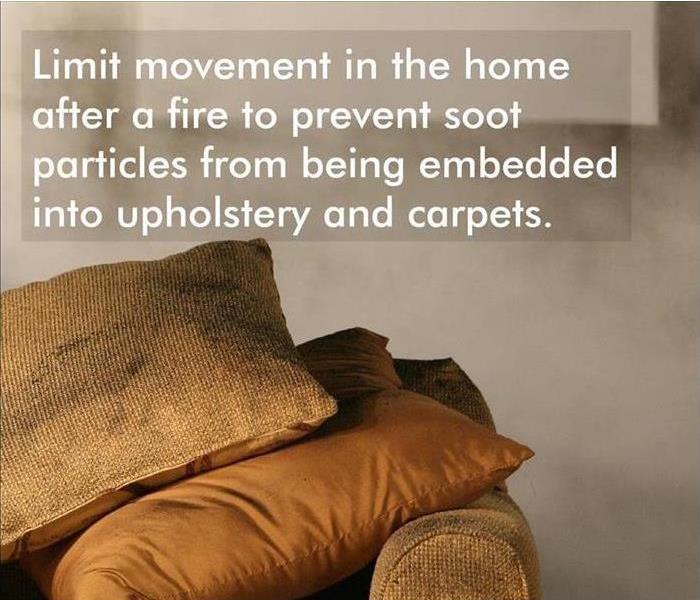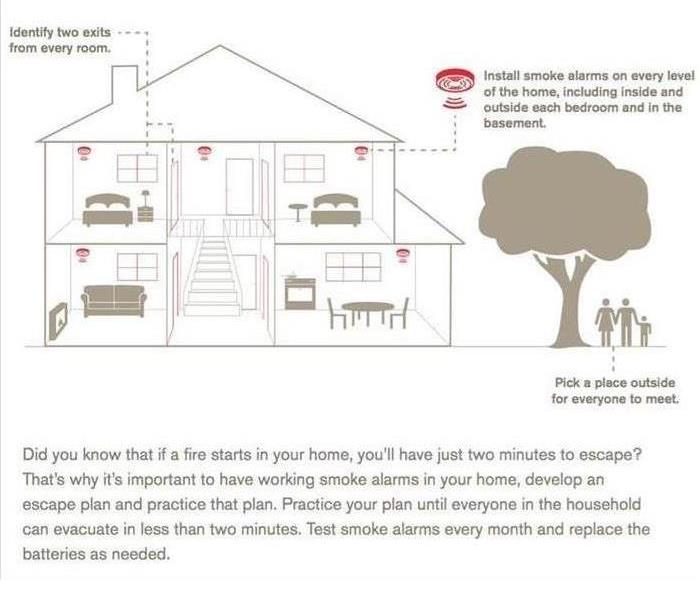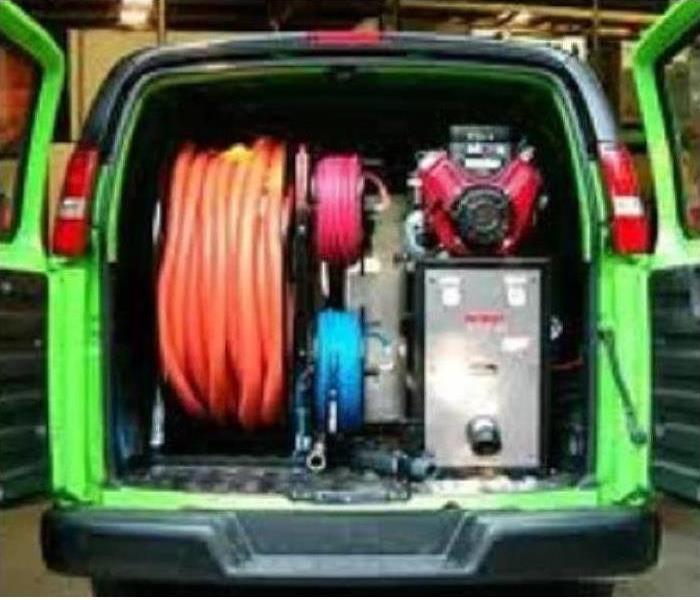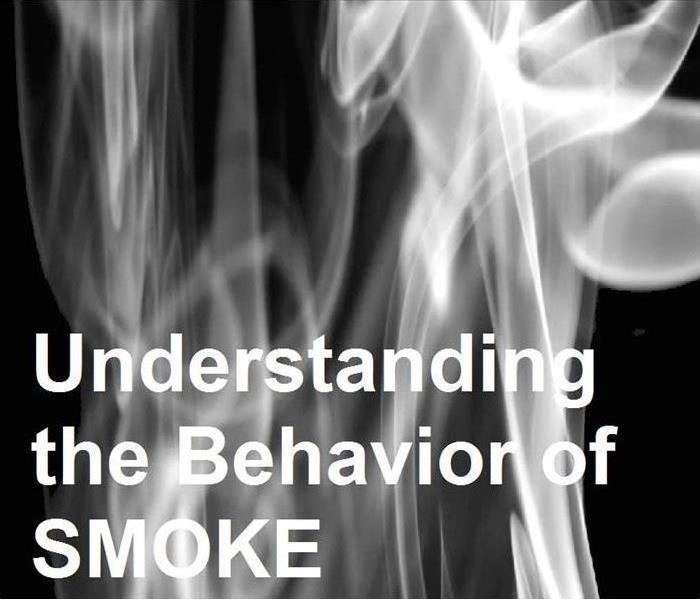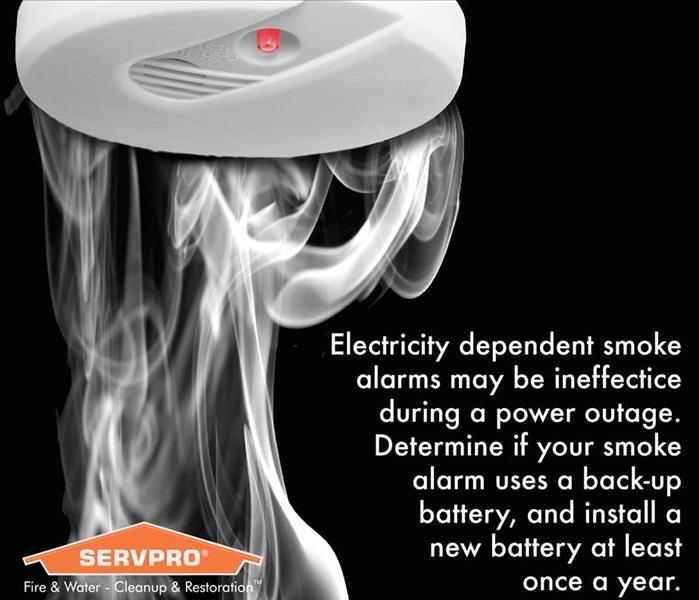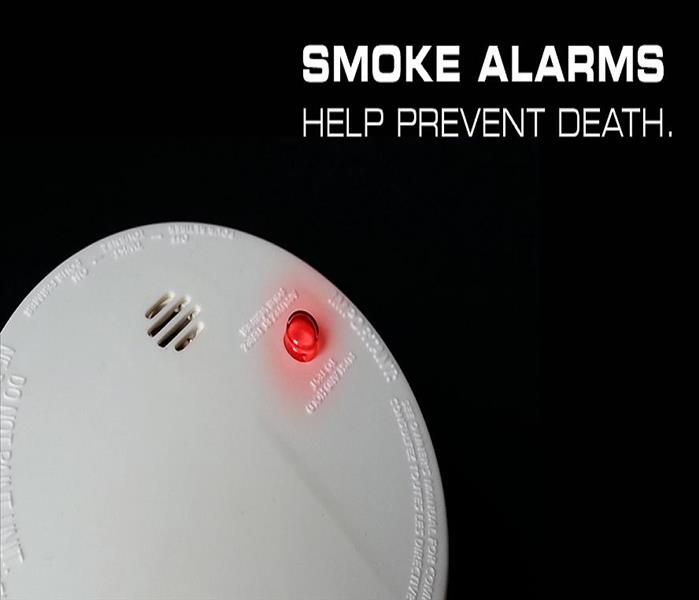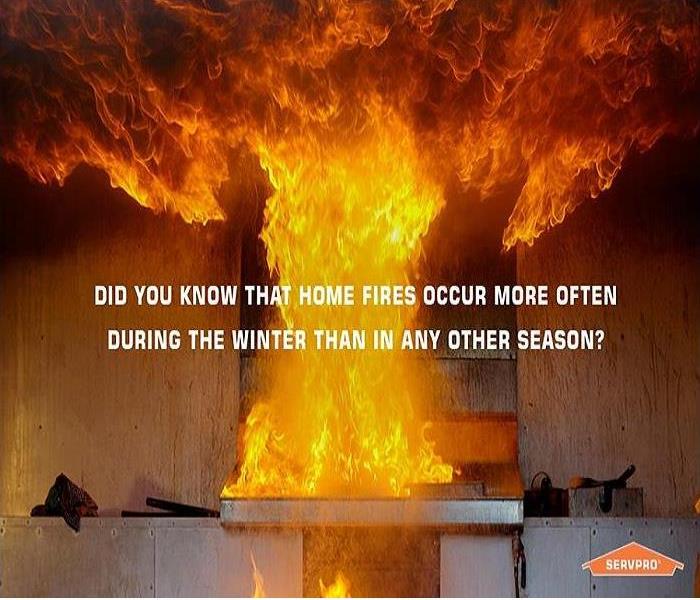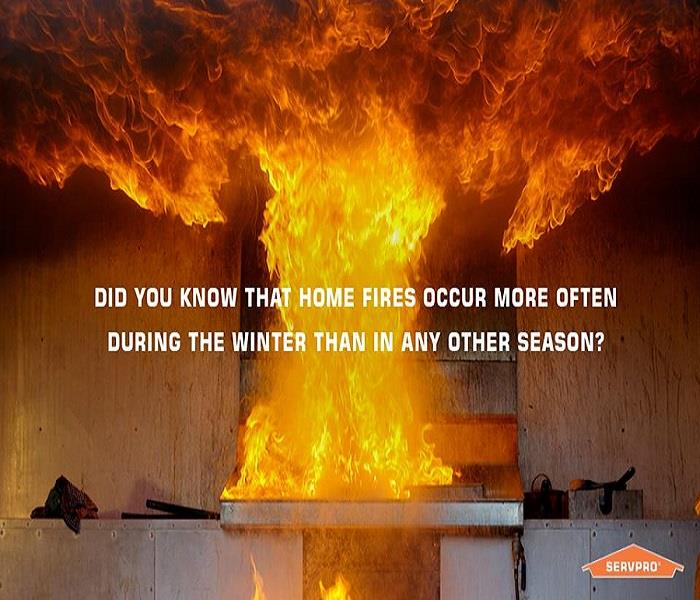Recent Fire Damage Posts
Summer Backyard Safety Tips | SERVPRO® of Eastern Rockland County
7/17/2023 (Permalink)
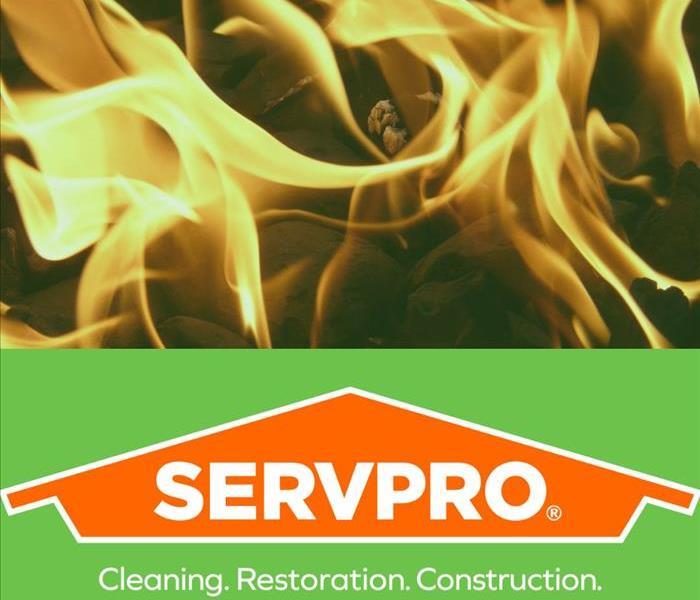 Restoring fire and smoke damage is one of our specialties. Contact SERVPRO of Eastern Rockland County to learn more.
Restoring fire and smoke damage is one of our specialties. Contact SERVPRO of Eastern Rockland County to learn more.
The summer season means the rise of backyard events like family reunions and graduation parties, gender reveals, and church socials, all of which definitely call for a good barbecue session. What’s a party without chicken wings, right?
Unfortunately the rise in backyard activity also brings with it an increase in fires.
So what can you do to ensure your backyard parties are safe this season? Here are a few places to start:
The grill. Whether it’s propane, charcoal or a big fancy smoker, your grill needs fire to get going, and that makes it an automatic danger. Make sure the grill is sturdy and in good working order, and that it has no breaks, leaks or rusted-out spots. Never use liquid accelerants once the fire is going, and make sure the grill is safely away from anything flammable, including the side of the house. And don’t forget about cleanup! Almost 20% of grill fires are due to poor cleaning.
The fire pit. A favorite gathering place for many, the fire pit is a wonderful place for having conversation and roasting marshmallows in the evening. But make sure you are doing it safely. Never leave any fire unattended, and never leave children unattended beside any fire. Make sure you have a bucket of water with which to douse any errant flames, and use that same bucket to slowly, safely put out the fire when you’re finished. And avoid adding anything like leaves or pine needles to your fire, because those can easily create flying embers that put your yard and neighborhood at risk of wildfire.
The chimney and dryer vent. These aren’t technically backyard-related, but you should do them anyway while you’re thinking about fire safety in the spring or summer. Make sure your chimney gets clean and clear of built-up ash or soot, and check your dryer’s vent pipe to make sure that lint hasn’t gathered inside.
Your local SERVPRO technicians are on hand 24⁄7 for emergencies. If you encounter fire damage at your home or business, no matter the cause, we will be there faster and have it cleaned up sooner. Call or click today and experience the SERVPRO difference.
Call SERVPRO When the Smoke of a Fire Disaster Has Cleared | SERVPRO® of Eastern Rockland County
2/9/2023 (Permalink)
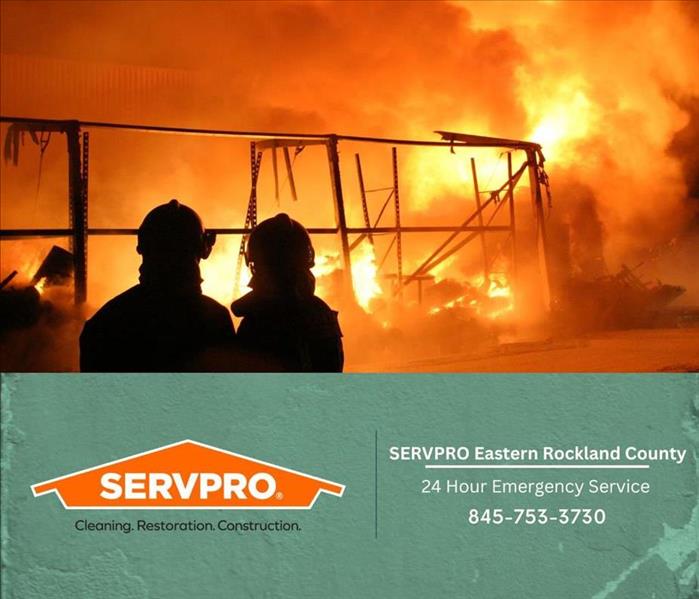 For quick repairs following a fire, get in touch with our team at SERVPRO of Eastern Rockland County.
For quick repairs following a fire, get in touch with our team at SERVPRO of Eastern Rockland County.
Disasters are one of those things that we all hope never happens, but when they do, they can leave a wide variety of damages behind. While there are lots of ways we can be affected by disasters, a fire is one that will almost always leave a path of destruction.
Cleaning up after a fire emergency can feel daunting and scary, but when you have neighbors like SERVPRO in your community, you can rest assured that you are far from alone. We will walk with you through the entire process and get you back on your feet in no time.
Our Initial Move
When you are affected by a fire, your first priority has to be securing the safety of yourself and your family. After that, call our experts to start down the road of recovery.
We can take your call at any time of night or day, and we will start creating a plan immediately by gathering as much information from you over the phone. Our team will be headed your direction in no time with the proper equipment and resources to get things started.
On site, we will first assess the damage as we continue to create a plan that will meet the unique needs of your situation. No two disasters are the same, and we want to ensure that every part of your restoration is covered.
Time to Get to Work
Removing smoke and soot damage from everything it has penetrated will start once the area is secured. Smoke and soot can reach rooms that never even saw flames, so we will clean walls, floors and ceilings anywhere there is sign of damage. Surfaces will also be sanitized to remove and stop additional odors.
The Most Crucial Step
Once the cleaning process has been completed, our team can get down to the real restoration of your home. This means we will start to put everything back together, including hanging drywall, laying floors or painting a room.
If part of your property could not be salvaged and demolition took place, our team is experienced in construction. We can rebuild an entire room if necessary. It is our goal to put your home back together exactly as you want it. At SERVPRO, we have years of experience, and we are always ready to help.
For rapid repairs following a fire, get in touch with our team at SERVPRO of Eastern Rockland County! We will work as quickly as possible to return you to a safe and fully restored property.
Warm Up and Stay Fire-Safe | SERVPRO® of Eastern Rockland County
1/26/2023 (Permalink)
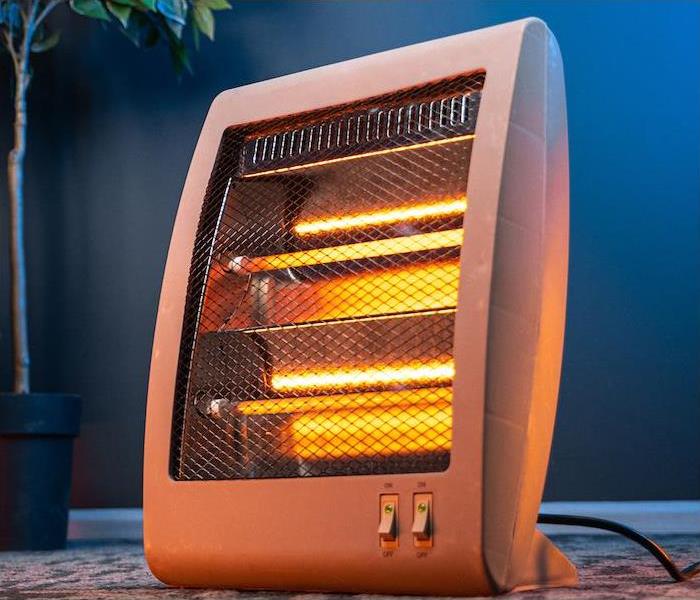 Call SERVPRO of Eastern Rockland County if you experience any smoke, soot or fire damage.
Call SERVPRO of Eastern Rockland County if you experience any smoke, soot or fire damage.
It might seem like winter has already been here forever, but it didn’t officially start until Dec. 21. While you may have flipped the heating on in your home long ago, without the proper preparations, you could have a fire hazard.
Love them or hate them, the cold months are here and you should be able to stay warm all season. Take steps now to stay fire-safe.
<h3basics">Furnace Basics
Homes in our area likely have one of three kinds of heating systems: a boiler, a furnace or baseboard heaters. Boilers run on water or gas and use radiant heat to warm your home, while baseboard heaters warm a single room at a time. Furnace systems are highly efficient and cost-effective systems that can outlast a lot of heating equipment.
No matter what kind of system you have, regular maintenance is the best way to keep them running long-term. Clean your furnace and baseboard heaters for dust, and have your boiler inspected regularly to ensure the heating elements are in working order.
Replace any filters in your systems often. For a furnace system, 90 days is the recommended timeframe, although you may want to do it more often if you have pets or someone in the home has allergies. Use the changing season as a good reminder to change your filter.
The air filter not only helps to lengthen the lifespan of your system, but much like a boiler heats without increasing the dust in your home, furnace filters can also eliminate dust and allergens.
<h3safety">Fireplace Safety
Fireplaces make for a cozy centerpiece in your home and can provide additional heating during one of the many snowstorms we experience. Without proper inspections and maintenance, though, a chimney or fireplace can pose quite the fire hazard for your home. Both artificial and wood-burning fireplaces should be inspected and cleaned regularly.
To care for a wood-burning fireplace, clean out ash and soot and ensure that nothing has blocked the chimney. Artificial fireplaces should be dusted regularly, including any removable logs and the cover you use on the front of the fireplace.
<h3heaters">Portable Heaters
Another source of heat commonly used in home is space heaters These portable heaters are great for warming a room quickly, much like the baseboard heaters commonly found in a lot of homes in this county. Running a space heater does require safety measures in order to prevent fires though.
Don’t run your space heater overnight, and always keep it three feet away from any combustible materials. Make sure your space heater is on a flat surface where it won’t get knocked over, and if your heater doesn’t have an automatic shut-off feature when it is tipped, consider upgrading to a new one. Always plug space heaters directly into the wall to avoid electrical surges.
Keep a close eye on the little ones and the furry ones in your home when you are running your heating equipment. Make sure they understand how to stay safe, since it only takes a single accident to cause complete chaos and destruction in your home. Stay cozy this season without the fear of fire.
If you experience fire damage this season, give us a call at SERVPRO of Eastern Rockland County for immediate assistance. We’re here 24⁄7 when you need us!
Staying in Control When You Burn Outdoors | SERVPRO® of Eastern Rockland County
7/26/2022 (Permalink)
Imagine this evening: You and your loved ones are sitting near a fire roasting hot dogs, making s’mores and sharing stories. What beautiful memories you can make!
Fire serves us in multiple ways during our day-to-day lives. Cooking our meals, getting rid of bugs, cleaning out limbs and leaves and entertainment can feel safe, but any flame can quickly get out of control. The National Park Service found that 85% of wildfires are started by humans.
This past May, we saw the largest fire in Hudson Valley burn Harriman State Park. Our wildfire risk has been slowly rising over the years, and with so much of our area being wooded, we need to stay fire-aware all the time.
You can still enjoy an outdoor fire! Use your grill, roast marshmallows for s’mores and get rid of brush, just be sure to check safety codes and regulations. Put safety first each and every time you light a flame so your risk level stays at a minimum.
<h3fire-hazards">Recreational Fire Hazards
There will always be a risk when you light a flame, but campfires, fire pits, grills and recreational fireworks are some of the most common outdoor fire starters. On average, grills start close to 8,800 home fires each year, mostly due to operator error. Look at gas lines or propane tanks before grilling and never leave a hot grill unattended, even after the cooking is done.
If you are starting a campfire, find a place away from buildings or vehicles, and only use a match or lighter to get the flame going. Once the fire has started, use only approved firewood to keep it going, and once you have been through all the chocolate, watch the embers and make sure they go completely out.
Fire pits are in a lot of backyards now, allowing for a camp feel with extra privacy. Fire pits still carry risks, though, and you should use the same precautions as a regular campfire. If it is moveable, keep your pit off of wooden surfaces or areas with an overhang.
Burning excess construction materials or other household waste in your fire pit may seem like an easy solution, but you should stick to approved firewood.
If you want to end an evening with a bang, small novelty fireworks and sparklers are permitted in our county. Be sure you have plenty of space to light the fireworks away from structures, vehicles or areas of dried grass.
Don’t forget that sparklers are still considered an explosive and should not be handled by small children. Leave plenty of room for fireworks to land, and always keep a bucket of water nearby.
<h3outdoor-fire-hazards">Other Outdoor Fire Hazards
Even with the risks, fires and combustibles still have a purpose. If you have a lot of trees that lose their leaves, burning them may be a viable means of cleanup, particularly if you do not live in an area that offers waste disposal options.
Clearing your yard of debris is important to protect against wildfires, and combined with purposeful landscaping, your yard serves as a line of defense for your home when a fire does start outside. Understand how to burn safelyand stay in control of your flames.
If you store gas in a shed or garage for your yard tools, make sure you use approved containers only and far away from any children. Gas should be used to power those items that need it only, so even if your campfire is going out, don’t grab the gas.
If you are going to have a flame out outdoors, be sure to check the weather and any warnings that may be in place. If the wind is strong or the relative humidity is low, wait on the fire and hang onto the marshmallows.
If you experience damage from a fire, give us a call. SERVPRO is ready with the equipment and knowledge for every aspect of fire recovery, and we want to restore as much of your property as possible, as quickly as possible.
Burn safely outdoors. And save some chocolate for us! If you have experienced fire or smoke damage, contact us today to get restoration started faster.
A Few Easy Steps to Prevent House Fires | SERVPRO® of Eastern Rockland County
6/9/2022 (Permalink)
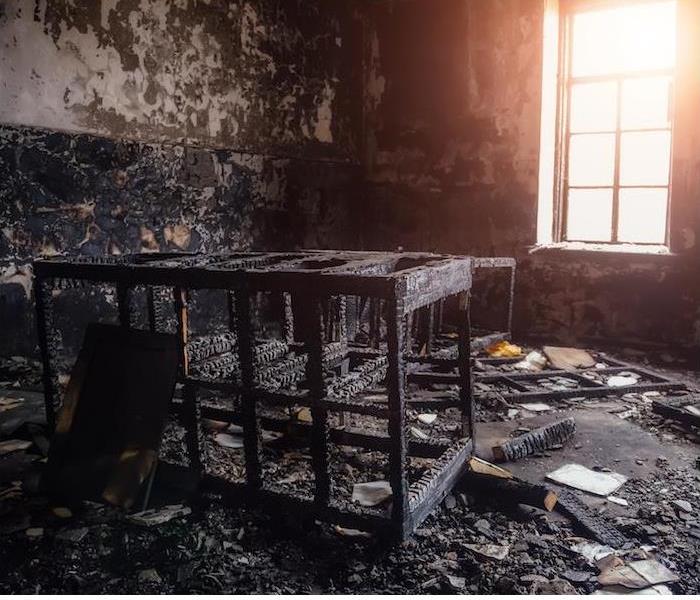 If your home is damaged in a house fire, SERVPRO of Eastern Rockland County is here to help. Contact us for any fire restoration needs.
If your home is damaged in a house fire, SERVPRO of Eastern Rockland County is here to help. Contact us for any fire restoration needs.
Since the start of 2022, the American Red Cross has responded to at least 20,000 house fires, and that only represents a small portion of the total number of fires that have occurred so far this year in the United States.
Hopefully, you have several smoke detectors already installed in your home as they remain the top way to protect your life, but there are several other ways you can prevent fire. Cleaning a few specific areas can do a lot for preventing damaging fires.
<h3the-clutter">Clear the Clutter
Clutter is likely not your favorite part of your home, so use this as a motivator to clean it out: Clutter can actually create a fire hazard. When hallways, stairwells or utility spaces fill up with items you don’t use on a regular basis, it can not only block essential emergency exit routes—it can also serve as fuel and quicken the spread of a fire once it starts.
Cloth items such as blankets, pillows or clothing can actually start a fire if left near a water heater. When you keep your space open, you not only can get out quickly when you need to, but you can also slow down the progression of flames.
Another area of the home you should address is your electrical outlets and extension cords. Overloaded extension cords are a common source of house fires. Remove any unused electrical appliances, and unplug those that you don’t use often.
Structure fires and home fires are the highest occurring types of fire in our neighborhoods, and since most of us live in smaller spaces that are densely populated, keeping your home free of hazards is especially important. Kitchen fires are the No. 1 source of all fires, so pay particular attention to your outlets and appliances here and never leave cooking unattended.
Ensure there is room between walls and furniture so that outlets do not overheat and air is able to flow freely.
<h3a-defensible-space-in-your-yard">Create a Defensible Space in Your Yard
Your yard can be the first defense in protecting your home from a fire that originates outside. Landscaping that is laid out intentionally can prevent fires from reaching your doorstep while allowing for firemen to work.
Strategically created areas in your yard are called defensible zones. This type of landscaping is so effective in the fight against wildfires that some states like California have imposed certain requirements for homeowners. New York may be densely urban, but that does not make us immune from wildfires, so this kind of landscaping is smart for all of us.
This doesn’t mean you can’t plant your favorite flowers; instead, it requires the strategic placement of plants to provide the maximum protection. You should also keep your yard clear of dead plants, leaves and tree limbs as these only provide fuel to fires.
<h3it-clean-keep-it-safe">Keep It Clean & Keep It Safe
Clearing the clutter in your home and yard are not the only ways you can clean your way to a safer home. Deep-clean your stove and have your chimney cleaned regularly to eliminate two more high-risk areas in your home.
Lowering your risk of fire isn’t all deep-cleaning, though, since even dusting can help a great deal. Pay special attention to dust gathering around outlets and other electric appliances.
Our homes are our safe space. They serve us as offices, schools and play areas these days, so keeping them safe is even more essential.
If you have experienced fire damage or want to learn more about our fire damage restoration services, contact us today. We’re here to act fast, 24⁄7.
Portable Fire Extinguishers: What You Need To Know To Keep Your Nanuet Home Safe
2/17/2022 (Permalink)
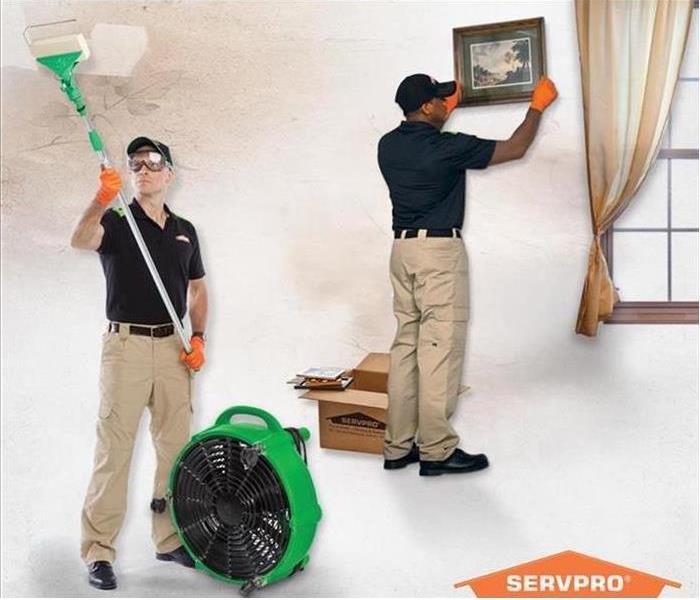 SERVPRO of Eastern Rockland County is locally owned and has been serving the Rockland County Community for over 25 years.
SERVPRO of Eastern Rockland County is locally owned and has been serving the Rockland County Community for over 25 years.
Fire extinguishers can be life and property saving tools when used correctly. In order to operate an extinguisher, the National Fire Protection Association (NFPA) suggests remembering the word PASS:
- Pull the pin. Hold the nozzle pointing away from you and release the locking mechanism.
- Aim low. Point the extinguisher at the base of the fire.
- Squeeze the lever slowly and evenly.
- Sweep the nozzle from side-to-side.
Read the instructions on the fire extinguisher and become familiar with them before a fire breaks out. Remember, extinguishers do have limitations. It is also important to ensure you have the correct type of extinguisher for your home or facility. To find more information on choosing the appropriate class of extinguishers, please visit the NFPA website.
If your property does sustain damage from a fire, SERVPRO® understands that using professional equipment makes a measurable difference in reducing claims loss expense. When time matters, technology and equipment must be counted on to perform.
SERVPRO® of Eastern Rockland County Service Technicians will answer your call with fast action, exceptional equipment, and trained personnel. Certainly, the right tool for the job is vital to timely mitigation and restoration, but perhaps more important, SERVPRO® fire damage professionals are thoroughly trained in fire cleanup and restoration. Knowing the different types of smoke and their behavior patterns are vital to proper restoration.
- Wet Smoke – Plastics and Synthetics; Low heat, smoldering, pungent odor, sticky, smeary.
- Dry Smoke – Paper and Wood; Fast burning, high temperatures, dry, powdery, non-smeary residues.
- Protein – Virtually invisible, discolors paints and varnishes, extreme pungent odor.
- Fuel Oil Soot – Furnace Puff Backs.
- Other Types – Tear gas, fingerprint powder and fire extinguisher residue.
Pretesting determines the proper cleaning method and allows the SERVPRO® technicians to focus on saving your precious items.
Deodorization Equipment Ultra Low Volume (ULV) Foggers will atomize liquid deodorizing agents, producing a fine mist that easily penetrates sites where odor-causing residues accumulate. The device can also be used to apply fungicides and disinfectants.
Thermal Foggers dispense solvent-based products in large volume, dense fogs suitable for confined areas. The fog consists of tiny particles of deodorant solution that pair with and neutralize odor-causing particles.
Call SERVPRO of Eastern Rockland County to learn about all our Fire cleanup services.
Visit our Google listing at SERVPRO of Eastern Rockland County Google Page
Starting and Stopping a Fire Involve the Same 4 Elements | SERVPRO® of Eastern Rockland County
1/25/2022 (Permalink)
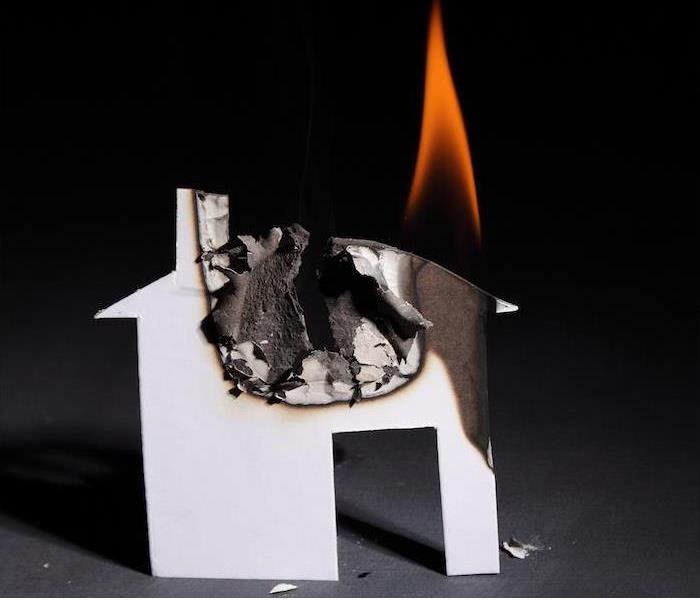 If your home or business has any damage, SERVPRO of Eastern Rockland County is ready around the clock to help you recover.
If your home or business has any damage, SERVPRO of Eastern Rockland County is ready around the clock to help you recover.
Squares and circles get most of the glory when it comes to geometric shapes (honorable mention to the rhombus), but when it comes to fire theory, the story begins and ends with the 3-D triangle called the tetrahedron.
Having four equal sides makes fire tetrahedron the perfect shape to explain how fires get started, because every fire requires the same four things to happen in tandem.
The 4 Things a Fire Needs to Live
Fuel. Think about this in the sense of fueling an old train engine by adding logs or coal. Any fire has to have something to devour, and that can range from dry leaves in your yard to the insulation behind your walls.
Heat. Remember using a magnifying glass to harness sunlight and catch pieces of paper on fire? That wasn’t just us, was it? The glass causes the sun’s heat to focus on the paper’s surface until it reaches a point at which it combusts. Until a material reaches that point, it won’t catch fire.
Oxygen. Fires have to consume oxygen, and the oxidation process both releases heat and generates more combustible gases, thus contributing to…
Chemical Chain Reaction. The continuation and growth of a fire depends on a chain reaction, which must be allowed to repeat and feed itself as the other three elements continue to be absorbed and utilized.
The 4 Ways to Stop a Fire
Cool it. If we polled 100 people and asked them the top way to start a fire, the survey would likely say, “Pour water on it.” Pouring water on the fuel source cools it and restores the thermal balance at which combustion becomes impossible.
Smother it. Fire blankets can stop a small fire almost instantly. Stamping out an errant spark from a bonfire or covering a grease fire with a pan lid—these all work by separating a fire from its oxygen supply, thus smothering it.
Starve it. Fires that have no fuel sources cease to be fires, because they have to have something to consume. Once consumption ends or the fuel source is removed, the fire dwindles and stops burning.
Interrupt the chain reaction. A gas called halon, though it’s now banned from production, proved incredibly effective in fighting fires by disrupting the chemical reaction that promotes combustion. Other halon replacements continue to be in use, and they are especially handy in that they are “clean” solutions that leave no residue and don’t conduct electricity.
If the fire tetrahedron makes a wreck of your home or business, we’re ready around the clock to help you recover. Contact SERVPRO anytime for fast, thorough cleanup and recovery after a fire.
24-Hour Service When You Need it Most | SERVPRO® of Eastern Rockland County
12/30/2021 (Permalink)
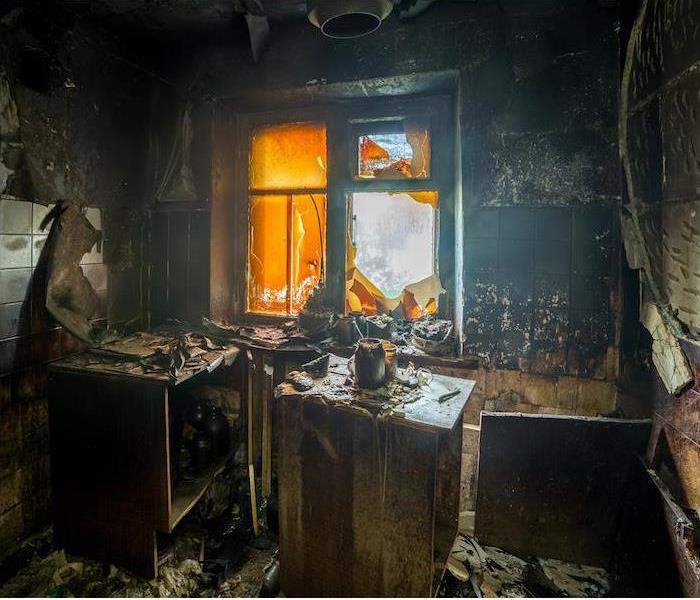 If a fire issue happens during the holidays, remember the trusted leader in the recovery industry, SERVPRO of Eastern Rockland County.
If a fire issue happens during the holidays, remember the trusted leader in the recovery industry, SERVPRO of Eastern Rockland County.
Remember waiting for things?
It was the worst. Before the advent of same-day delivery, order-ahead apps and instant pots, there were things you simply couldn’t get right away.
And before 24-hour emergency service, cleanup and recovery for damaged homes was one of those things.
But now we live in the “now” age, and you can get instant help from your Eastern Rockland County SERVPRO mere moments after you experience a recovery need at home or at your business, even if it happens in the middle of the night or on a holiday weekend.
That’s not only convenient, it can save you further trouble and cost.
After a fire. The immediate effects of a fire are painfully obvious to the eye. But you may not realize the hidden, quick work being done by soot, the tiny, sticky particle bits left over after incomplete combustion. These latch on to carpet and surfaces instantly and start digging in, creating stains in minutes.
In a matter of a few hours, soot and its partner smoke can cause irreparable damage to walls, ceilings, flooring and furniture. You don’t have time to wait, and we won’t make you.
After water damage. The timeline to active mold after water damage is a measly 48 hours. After that time, you’re guaranteed to have mold on damaged walls and affected surfaces in moistened areas. It’s imperative that water be removed and thoroughly extracted from your home right away, because mold can cause health problems, as well as threaten your home’s structural integrity.
There are all kinds of possibilities for acute damage when storms and natural disasters rip through town as well. And while you can’t be fully prepared for all of them, you can know the right call to make to get help as soon as your issue presents itself. Whether it’s a burst pipe or a tornado, you always know you’ve got help right away when you call the industry leaders at SERVPRO.
When you need help after a home or business disaster, fast service is a priority, and there’s nobody faster or more prepared than SERVPRO. Call us anytime to take advantage of our 24-hour emergency service.
A Quarter of All Fires Start at Home | SERVPRO® of Eastern Rockland County
11/11/2021 (Permalink)
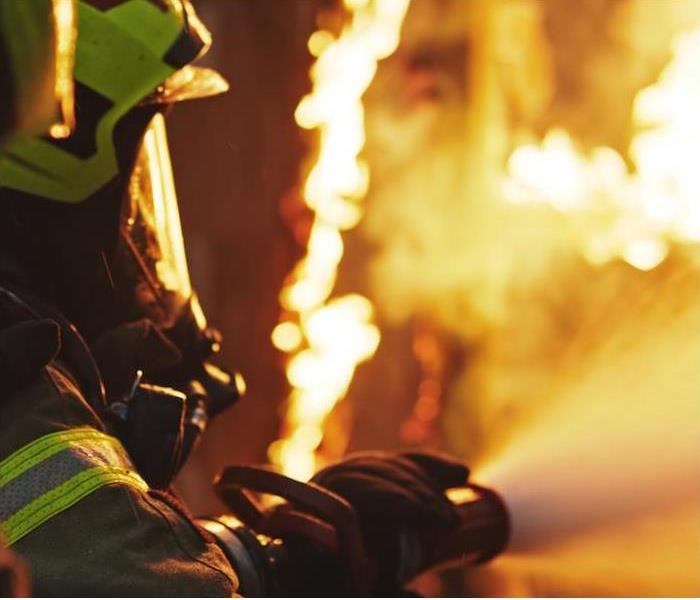 Regardless of the cause, SERVPRO of Eastern Rockland County are here for you if your home is affected by fire.
Regardless of the cause, SERVPRO of Eastern Rockland County are here for you if your home is affected by fire.
Fires at home are still a problem, despite practical education, advances in technology and visible ad campaigns to try and help us put them to an end.
How are these fires getting started, and what can we do to prevent them? Let’s dive in and take a look.
Cooking. Whenever you’re dealing with hot oil, grease and heating elements, you run the risk of something getting out of hand. And it stands to reason that the occasional fire would result from grilling or a stovetop accident. But the frustrating thing about this statistic is the fact that most of the whopping 49% of home fires that start in the kitchen happen because of unattended cooking. You read that right—the No. 1 cause of the 350,000 annual home fires in the United States is people not paying attention while they cook.
Heating equipment. When the weather gets colder, we use heaters to keep the house cozy, which introduces a natural risk of fire. Space heaters in particular have a reputation for sparking the combustibles around them, or starting fires when they overheat or tip over. If you use space heaters, make sure you’ve got a new one with more safety features.
Electrical fires. Think about how many things in your home right this second are chewing up electricity. That number may or may not get even higher depending on what time of day and who’s in the home. But if your home is older, it may not be equipped for all that electrical pull. And older wires are far more likely to fault, short-circuit or become damaged anyway.
Smoking materials. The lowest-ranking cause of home fires is, in a sense, the most costly—though only 5% of house fires are started due to smoking materials, they account for the highest percentage (almost a quarter) of all civilian fire fatalities.
Regardless of the cause, SERVPRO of Eastern Rockland County is here for you if your home is affected by fire. Contact your local team today to see how we can help.
Keep Fire Out of Your Fall Plans | SERVPRO? of Eastern Rockland County
9/16/2021 (Permalink)
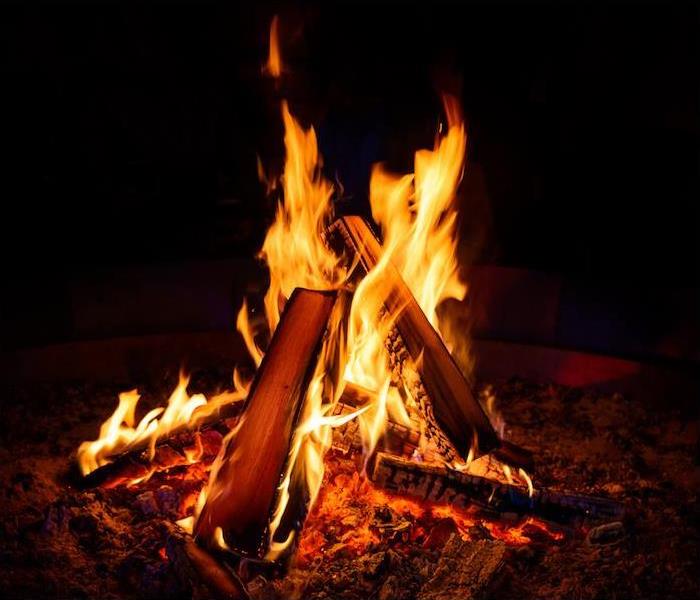 Be mindful about fall fire safety. Always remember that SERVPRO of Eastern Rockland County is the trusted leader in the restoration industry.
Be mindful about fall fire safety. Always remember that SERVPRO of Eastern Rockland County is the trusted leader in the restoration industry.
Ahh, autumn in New City. There’s just something magical about it—leaves are dropping and changing, there’s football everywhere you turn and everything smells like pumpkin spice.
Campers and hikers squeal with delight, and bags of candy begin to accumulate at your house to give out to costumed wanderers.
But even this most pleasant season brings potential for fire danger, so let’s take at a few areas in which you need to exercise caution.
Campfire Safety
Building a campfire properly is as important as putting it out properly. Use matches or a lighter only—never use an accelerant like kerosene or lighter fluid.
Build your fire safely out from under any low branches, and at least 25 feet from any structures, buildings or tents.
Make sure your fire is completely extinguished before you leave camp. Douse every last ember with water until the wood and ash is cool to the touch.
Leaf Burning
You have a few options when it comes to leaf removal. You could have them hauled away or mulched, but some residents choose to burn them as well.
You’ll need a permit and proper fire safety methods, however. Build any open flame at least 50 feet away from your home, and use a burn barrel if you can.
Also, burning anything besides organic yard material is prohibited, as it presents both fire and environmental hazards.
Space Heaters
Portable space heaters are a major cause of home fires as weather cools down. If you’re using one to heat your personal space on cool mornings or evenings, make sure to keep it at least three feet from anything that is flammable, including furniture, curtains or clothes.
Keep heaters on a level surface away from any activity, and upgrade to a newer model with tip-over or overheating sensitivity.
Halloween
We’ll get into detail later, but as you decorate for spooky season, make sure you’re keeping fire safety in mind, especially with the use of candles.
If a fire hazard should turn from potential to reality in your home, remember the trusted leader in the fire cleanup and recovery industry and contact SERVPRO to get your property fully restored right down to the smell of smoke.
Your Surroundings Can Protect You From Wildfire | SERVPRO® of Eastern Rockland County
7/23/2021 (Permalink)
 If your home is damaged by fire or any other reason, SERVPRO of Eastern Rockland County is ready and able to repair any damage.
If your home is damaged by fire or any other reason, SERVPRO of Eastern Rockland County is ready and able to repair any damage.
It’a a nightmare scenario for any home or property owner—seeing a wildfire come near and threaten to destroy one’s home. It may not happen often in New York, but wildfires are more common than you think. And considering the speed and veracity with which they spread, and how much combustible material is all around, it’s a wonder we can contain them at all.
But there are practical steps we can take to prevent and combat wildfires, beyond the significant difference we could make by just being more careful.
Let’s look into one of those steps: defensible space.
What Is Defensible Space?
It’s not about fighting Martian invaders—“defensible space” is a wildfire defense method employing a series of buffer zones you create around your property. By planting and pruning intentionally and purposefully, removing things like dead trees and brush which help fire spread quickly, and adding areas of hardscape or gravel around your perimeter, you can give your property a fighting chance against wildfire.
Think of it as a safety barrier (aka defense), designed to safeguard your home by slowing or removing a fire’s fuel supply as it approaches your home. It also gives firefighters a better chance of stopping a wildfire before it reaches the house.
Defensible space isn’t required by law in New York, but it’s a good practice to consider all the same.
Why Defensible Space Matters
While it’s true that the top states for wildfires are west of the Mississippi River, the fact is they can and do happen all over. There were over 59,000 wildfires across the United States in 2020, and almost 200 of them were in New York, burning up over 1,100 acres of land. (Told you we’d prove it.)
Even without California’s 10,000+ wildfires, that leaves an average of almost 1,000 fires per state, and what’s more, the first six months of 2021 have seen a 25% increase in fires already.
Defensible space is one more way we can make a difference in preventing and slowing destruction caused by wildfires.
SERVPRO of Eastern Rockland County is a experienced fire restoration company. After you have the safety plan in place, have our phone number on hand in case your home has a fire damage event. We have trained Service Technicians on call 24 hours a day, 365 days a year to help you in case of an emergency. Visit Fire Damage Services to learn more.
If your home is damaged by fire of any sort, wild or not, SERVPRO is ready and able to repair the damage caused. Get in touch today to get the pros on your team.�
What To Do Before Help Arrives to Your Rockland County Home
4/30/2021 (Permalink)
A fire can leave behind soot, smoke damage and a host of other problems.
Ceilings, walls, woodwork, carpeting, and floors will often need a thorough professional cleaning. If your Nyack, or Nanuet Rockland County home or business suffers a fire, it is important to take the appropriate steps to prevent further damage. The following tips may help reduce damage and increase chances of a successful restoration.
Do:
- Limit movement in the home to prevent soot particles from being embedded into upholstery and carpet.
- Keep hands clean. Soot on hands can further soil upholstery, walls and woodwork.
- Place dry, colorfast towels or old linens on rugs, upholstery and carpet traffic areas.
- If electricity is off, empty freezer/refrigerator completely and prop doors open to help prevent odor.
- Wipe soot from chrome kitchen/bathroom faucets, trim and appliances, then protect these surfaces with a light coating of lubricant.
- If heat is off during the winter, pour RV antifreeze in sinks, toilet bowls, holding tanks and tubs to avoid freezing pipes and fixtures.
- Change HVAC filters; leave system off until a trained professional can check the system.
- Tape double layers of cheesecloth over air registers to stop particles of soot from getting in or out of the HVAC system.
Don't:
- Don't attempt to wash walls, painted surfaces, furniture or carpets. Instead call SERVPRO of Eastern Rockland County.
- Do not attempt to clean electrical appliances before consulting authorized repair service.
- Do not consume any food or beverages that may have been stored close to fire, heat or water, as it may be contaminated.
- Do not turn on ceiling fans. Wiring may be wet or damaged and cause electrical shock.
- Don't send garments to the dry cleaner. Improper cleaning may set in smoke odor.
The Behavior of Smoke
4/25/2021 (Permalink)
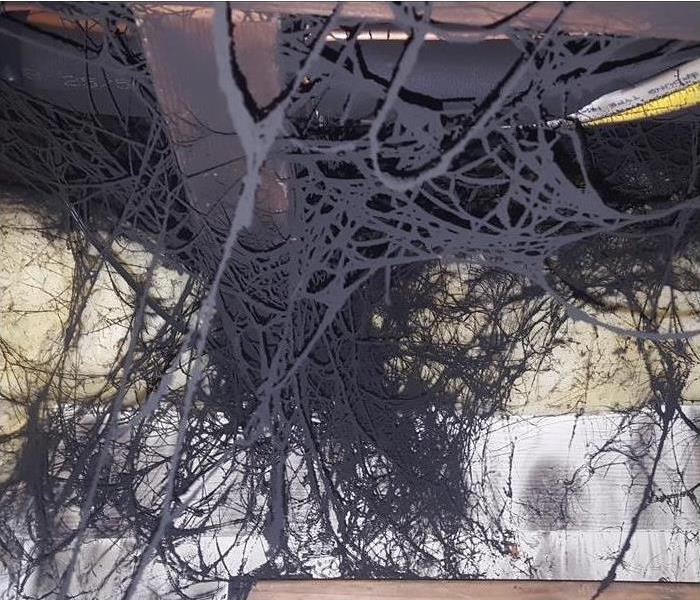 Soot Webbing
Soot Webbing
The damage to your Rockland County New York property following a fire can often be complicated due to the unique behavior of smoke.
There are two different types of smoke--wet and dry. As a result, there are different types of soot residue after a fire.
SERVPRO technicians are thoroughly trained in fire cleanup and restoration, and know the different types of smoke and its behavior patterns. Knowing this information is vital to proper restoration.
Before restoration begins, the technicians will survey the loss to determine the extent of impact from fire, smoke, heat, and moisture on the building materials and contents. The soot will then be tested to determine which type of smoke damage occurred. Pretesting determines the proper cleaning method and allows us to focus on your precious items.
Smoke can penetrate various cavities within the structure, causing hidden damage and odor. Our knowledge of building systems helps us to investigate how far smoke damage may have spread. The following are additional facts you may not know about smoke.
- Hot smoke migrates to cooler areas and upper levels of a structure.
- Smoke flows around plumbing systems, seeping through the holes used by pipes to go from floor to floor.
- The type of smoke may greatly affect the restoration process.
Types of Smoke:
Wet Smoke (Plastic and Rubber) Low heat, smoldering, pungent odor, sticky, smeary. Smoke webs are more difficult to clean.
Dry Smoke (Paper and Wood) Fast burning, high temperatures, heat rises therefore smoke dries.
Protein Fire Residue (Produced by evaporation of material rather than from a fire) Virtually invisible, discolors paints and varnishes, extreme pungent odor.
Fuel Oil Soot (Furnace Puff Backs) While "puff backs" can create havoc for homeowners, SERVPRO technicians can, in most cases restore the contents and structure quickly.
Other Types (Tear gas, fingerprint powder, and fire extinguisher residue) Special loss situations require special care.
Our SERVPRO of Eastern Rockland County technicians are trained to handle even the toughest losses. And make any smoke disaster "Like it never even happened."
Every Second Counts: Fire Safety
3/2/2021 (Permalink)
Every second counts during a fire. Fire experts agree; people have as little as two minutes to escape a burning home or work space. It is critical to be prepared and have an escape plan in place.
Once the plan is developed, it is critical everyone in the home or office understands the plan. The best way to do this is to discuss and practice the plan at least twice a year.
The following are a suggestions to help you develop an emergency escape plan:
- Draw a map of each level of your home or business and show all the doors and windows. Find two ways to get out of each room. Make sure all doors and windows that lead to outside open easily.
- Consider escape ladders for sleeping areas on the second floor. Only purchase collapsible escape ladders evaluated by a recognized testing laoratory.
- Choose an outside meeting place a safe distance from the home or business where everyone can meet. Make sure to mark this location on the map.
- Teach children how to escape on their own in case you are not able to help them.
Fire Prevention tips:
- Install smoke alarms and carbon monoxide detectors in your home and test them monthly.
- Don't Wait, Check the Date-Replace smoke alarms every 10 years.
- Store matches and Lighters safely, mainly out of the reach of children. Also, make sure you store them in locations where combustion or exposure to flames might be an issue.
- Practice proper cooking safety. Don't leave cooking food unattended, have a working fire extinguisher in the kitchen, keep children and pets away from the kitchen while cooking.
- Be careful with all open flames, never leave them unattended.
- Generators should always be used outside the home. Carbon monoxide poisoning can occur when a generator is not working or vented properly.
The key is to reduce risks by practicing fire safety in your home and business, while there are no guarantees taking these steps will help prevent fires and keep your property, family or coworkers safe.
SERVPRO of Eastern Rockland County is a trusted leader in the fire damage restoration industry. We are a local company with over 25 years of experience in fire damage cleanup.
Read our Fire Damage restoration services page to learn more.
Destroy Odors with Deodorization
3/2/2021 (Permalink)
Even small fires in your Rockland County home or business can cause odors for years to come if the affected areas are not properly cleaned and deodorized. Fire, smoke and soot damages in your home or business can create unpleasant and potentially permanent problems.As various materials burn the odorous residues and deposits on surfaces are left behind. Unless fast, professional action is taken, these residues and deposits can cause permanent damage to contents and may result in resurfacing odors.
We have Production Managers and Service Technicians certified by the Institute of Inspection, Cleaning and Restoration (IICRC), to handle specialized services that can rid your home or business of offensive odors left by fire or smoke damage.
Our services don't cover up the odor with fragrance; we seek out and remove the sources of the odor. Once the source is found, we use the SERVPRO proprietary line of cleaning products to treat and prevent the odor from returning. Any savable items in affected areas will also be professionally cleaned and deodorized, including furniture, draperies, upholstery, electronics, art, flooring, walls, ceilings, HVAC ducts and more.
We also handle other odors that may require deodorization:
- Cigarette Smoke
- Pet Odors
- Decomposition
- Mold
Whether its fire, water, mold damage, or just a stubborn odor that refuses to go away, SERVPRO of Eastern Rockland County will make it "Like it never even happened." Call to learn about our Fire Damage Cleanup Services (845)634-1660.
The Behavior of Smoke
3/1/2021 (Permalink)
The damage to your property following a fire can often be complicated due to the unique behavior of smoke.
There are two different types of smoke--wet and dry. As a result, there are different types of soot residue after a fire. SERVPRO of Eastern Rockland County technicians are trained in fire cleanup and restoration, and know the different types of smoke and its behavior patterns. Knowing this information is vital to proper restoration. Before restoration begins, the technicians will survey the loss to determine the extent of impact from fire, smoke, heat, and moisture on the building materials and contents. The soot will then be tested to determine which type of smoke damage occurred. Pretesting determines the proper cleaning method and allows us to focus on your precious items.
Smoke can penetrate various cavities within the structure, causing hidden damage and odor. Our knowledge of building systems helps us to investigate how far smoke damage may have spread. The following are additional facts you may not know about smoke.
- Hot smoke migrates to cooler areas and upper levels of a structure.
- Smoke flows around plumbing systems, seeping through the holes used by pipes to go from floor to floor.
- The type of smoke may greatly affect the restoration process.
Different Types of Smoke
Wet Smoke (Plastic and Rubber) Low heat, smoldering, pungent odor, sticky, smeary. Smoke webs are more difficult to clean.
Dry Smoke (Paper and Wood) Fast burning, high temperatures, heat rises therefore smoke dries.
Protein Fire Residue (Produced by evaporation of material rather than from a fire) Virtually invisible, discolors paints and varnishes, extreme pungent odor.
Fuel Oil Soot (Furnace Puff Backs) While "puff backs" can create havoc for homeowners, SERVPRO of Eastern Rockland County technicians can, in most cases restore the contents and structure quickly.
Other Types (Tear gas, fingerprint powder, and fire extinguisher residue) Special loss situations require special care.
Our technicians have the training and equipment necessary to handle even the toughest losses. And make any smoke disaster "Like it never even happened." To Learn more read our fire brochure
The Importance of Cleaning Dryer Vents
4/2/2019 (Permalink)
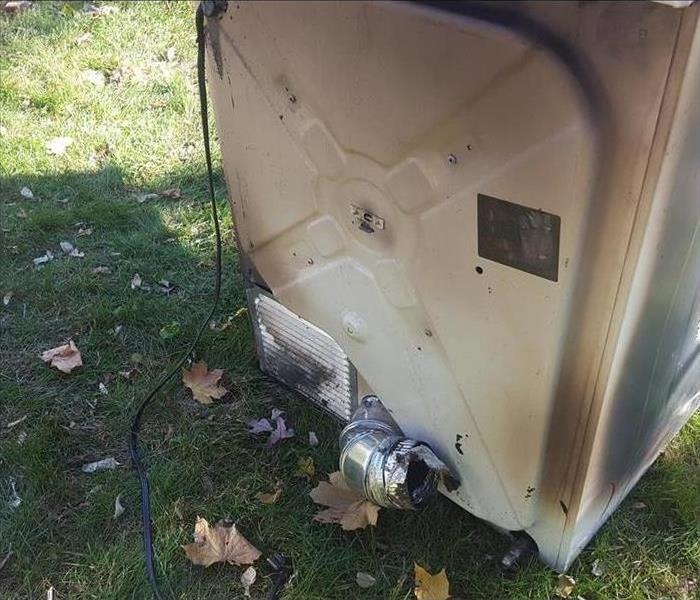 Dryer Fire
Dryer Fire
According to FEMA, failure to clean home dryers causes 34% of home dryer fires. Home dryer fires cause $35 million in property loss and can even cause injury or death. This Eastern Rockland County home had a fire in their laundry room. To reduce the risk of these fires happening in your home, clean dryer vents and ducts that may have lint buildup. Other tips for keeping your dryer vents clean from the National Fire Protection Agency include cleaning the lint filter before and after each load and making sure the outdoor vent flap will open and is not restricted by snow, a bird’s nest, or other potential obstacles.
Smoke Alrams: LIFE SAVERS
3/14/2019 (Permalink)
Smoke alarms save lives when properly installed and maintained, according to the National Fire Protection Association (NFPA).
In homes, smoke alarms should be in every bedroom and on every level, including the basement. In office and commercial environments, check your state requirements or contact your local Fire Marshall to help ensure all codes are met.
Test smoke alarms monthly using the test button. Smoke alarms with non-replaceable batteries need the entire smoke alarms unit replaced every ten years. If the alarm chirps signaling low battery, take the proper steps to replace the unit or the batteries immediately. Never disable or remove the battery from an alarm. Almost half the fires where smoke alarms were present but did not activate had missing or disconnected batteries (NFPA).
In larger commercial facilities, hard wired or wireless smoke alarms offer benefits such as not needing to be tested as often and activating throughout the entire building if smoke is detected in just one area (NFPA).
If you need help installing, testing, or changing batteries in your smoke alarms, contact your local fire department, an electrician or the American Red Cross.
Be sure your home or workplace has a fire emergency escape plan in place and conduct regular drills to ensure proper execution of the plan. The NFPA website is a good resource for information.
Celebrate Safely This Holiday Season
12/6/2018 (Permalink)
DID YOU KNOW?The Top Three days for home candle fires are Christmas, New Year's Day and Christmas EvePretty lights, candles and decorations are just a few of the items bringing charm and cheer to the holiday season, however, if they are not used carefully your holidays may go from festive to frightening very quickly. American Red Cross offers thefollowing safety tips:
- Place Christmas trees, candles and other holiday decorations at least three feet away from heat sources like fireplaces, portable heaters radiators heat vents and candles.
- Make sure light strings and other holiday decorations are in good condition. Do not use anything with frayed electrical cords.
- Always unplug tree and holiday lights before leaving the property or going to bed.
- Never use lit candles to decorate a tree. Always extinguish candles before leaving the room or going to bed.
- Use only sturdy tree stands designed not to tip over. Keep curious pets and children away from Christmas Trees.
- Keep anything that can catch fire-pot holders/mitts, wooden utensils, paper bags, food packaging, and towels or curtains away from your stove top.
- Designate one person to walk around your property to ensure all candles and fire places are properly extinguished after the guests leave.
Fires Are Preventable
10/4/2018 (Permalink)
When it comes to your home or business property, there are certain safety precautions that can be taken to help prevent fires.
Electrical and Appliance Safety
- Frayed wires can cause fires. Replace all worn, old or damaged appliance cords immediately ad do not run cords under rugs of furniture.
- If an appliance has a three-prong plug, use it only in a three-slot outlet. Never try to force it to fit into a two-slot outlet or extension cord.
- Immediately shut-off, then professionally replace, light switches that are hot to the touch and lights that flicker.
Fireplace and Woodstoves
- Inspect and clean woodstove pipes and chimneys annually and check monthly for damage or obstructions
- Use a fireplace screen heavy enough to stop rolling logs and big enough to cover the entire opening of the fireplace to catch flying sparks.
- Make sure the fire is completely out before going to bed or leaving the house.
Source: ready.gov
Smoke Alarms: Life Savers
8/23/2018 (Permalink)
Smoke alarms save lives when properly installed and maintained, according to the National Fire Protection Assoc. (NFPA).
Follow these tips:
- In homes, smoke alarms should be in every bedroom and on every level, including the basement. In office and commercial environments, check your state requirements or contact your local Fire Marshall to help ensure all codes are met.
- Test Smoke alarms monthly using the test button. Smoke alarms with non-replaceable batteries need the entire smoke alarm unit replaced every ten years. Other smoke alarms need batteries replaced every year and the unit replaced every ten years. If the alarm chirps signaling low battery, take the proper steps to replace the unit or batteries immediately. Never disable or remove the battery from an alarm. Almost half of fires where smoke alarms are present but did not activate had missing or disconnected batteries. (source NFPA)
- In larger commercial facilities, hard wired or wireless smoke alarms offer benefits such as not needing to be tested as often and activating throughout the entire building is smoke is detected in just one area. (source NFPA)
If you need help installing, testing or changing batteries in your smoke alarm, contact your local fire department, electrician or the American Red Cross.
(Source: Restoration Newsline Vol.29, Issue 9)
Fire Safety Tips
5/24/2018 (Permalink)
Fire Escape Plan5/24/2018
Follow these Fire Safety and Prevention Tips
Fire prevention should be your first concern. The next best thing is to make sure everyone in the household knows what to do if there is a fire in the home.
- Install smoke alarms and carbon monoxide detectors in your home and test them monthly.
- Know two ways out of every room in your home.
- Create a home fire escape plan, practice it at least twice a year.
- Identify a meeting place outside your home for your family or anyone who lives in the home.
- Don't Wait, Check the Date-Replace smoke alarms every 10 years.
- Store matches and Lighters safely, mainly out of the reach of children. Also, make sure you store them in locations where combustion or exposure to flames might be an issue.
- Practice proper cooking safety. Don't leave cooking food unattended, have a working fire extinguisher in the kitchen, keep children and pets away from the kitchen while cooking.
- Be careful with all open flames, never leave them unattended.
- Generators should always be used outside the home. Carbon monoxide poisoning can occur when a generator is not working or vented properly.
The key is to reduce risks by practicing fire safety in your home, while there are no guarantees taking these steps will help prevent fires and keep your family safe
Halt Winter Heating Fire Hazards
1/22/2018 (Permalink)
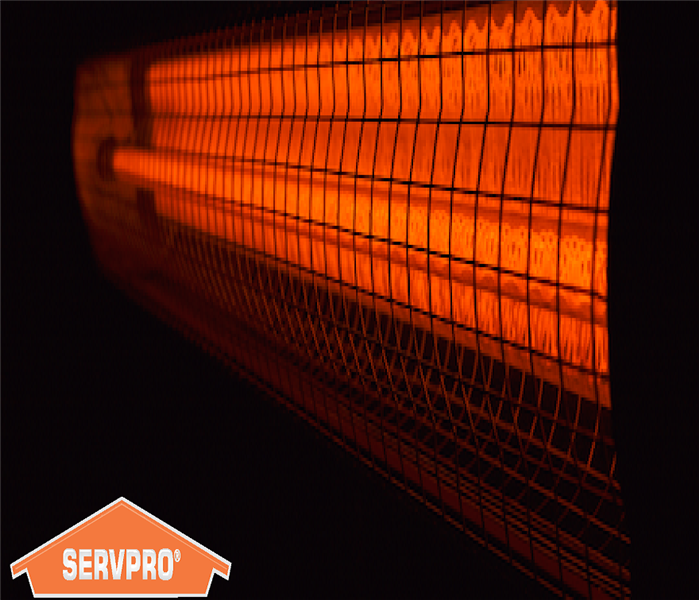 Fire, Cleanup
Fire, Cleanup
Did you know? 50% of all residential heating-related fires are reported during the months of December, January and February.
Keep the following safety tips in mind to help reduce your risk of a heating-related fire.
- Keep anything flammable at least three feet away from heating equipment., like the furnace, fireplace, wood stove, or a portable space heater. Have a three foot "kid free" zone around open fires and space heaters.
- Make sure the fireplace has a sturdy screen to stop sparks from flying into the room. Ashes should be cool before putting them in a metal container a safe distance away from your home.
- Remember to turn portable heaters off when leaving the room or going to bed.
- Always use the right kind of fuel, specified by the manufacturer, for fuel burning space heaters.
- Have heating equipment and chimneys cleaned and inspected every year by a qualified professional.
- Have a qualified professional install stationary space heating equipment, water heaters or central heating equipment according to the local codes and manufacturer's instructions.
- Test smoke alarms monthly.
If your property does suffer fire damage in your home or business, contact SERVPRO to help make it "Like it never even happened."
Carbon Monoxide: A silent Cold-Weather Killer
1/18/2018 (Permalink)
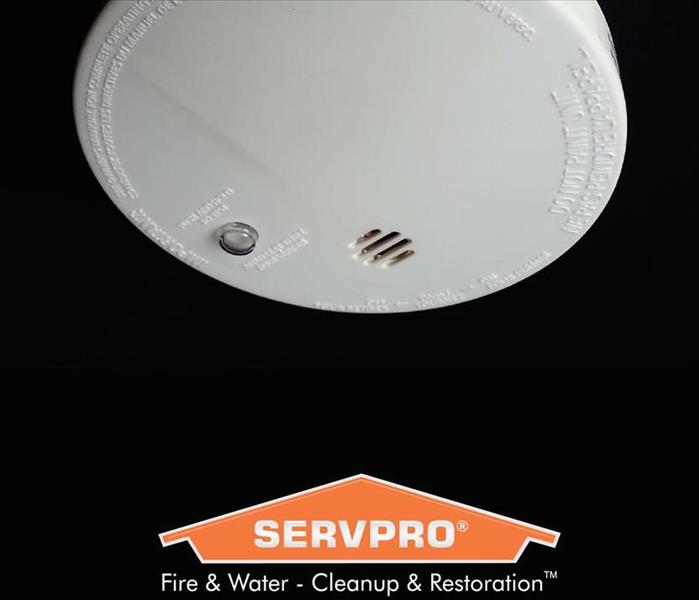
Carbon Monoxide is a gas you cannot see, taste, or smell. According to ready.gov, an average of 430 Americans die each year from unintentional carbon monoxide (CO) poisoning. Often times, it is the result of faulty, improperly used, or vented consumer products like furnaces, ranges, water heaters, room heaters and engine-powered equipment such as portable generators. There are precautions you can take to help protect yourself, your family and your employees from deadly CO fumes. Reduce CO fumes exposure in your home or workplace by performing regular maintenance on equipment and appliances that can produce CO. Install carbon monoxide detectors on every level of the home, including outside bedrooms. Consider having all fuel-burning heating equipment and chimneys serviced annually by a professional. Use portable generators only in well ventilated areas away from openings to prevent fumes from entering the home/building. Visit usfa.fema.gov or osha.gov for more info on CO safety.
Fireplace Safety Tips
12/21/2017 (Permalink)
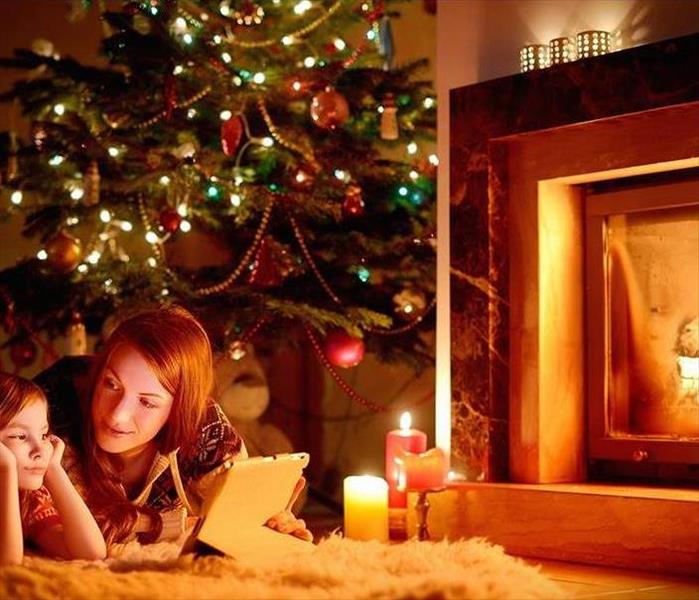 Fireplace Safety Tips
Fireplace Safety Tips
Curling up in front of a warm fireplace is one of the many joys of the fall and winter seasons. Every type of fireplace, whether wood-burning, gas, or electric, poses a potential danger to children.
Use these tips to keep your family safe from fireplace dangers:
- If possible, keep a window cracked open while the fire is burning.
- Be certain the damper or flue is open before starting a fire. Keeping the damper or flue open until the fire is out will draw smoke out of the house. The damper can be checked by looking up into the chimney with a flashlight or mirror. Do not close the damper until the embers have completely stopped burning.
- Use dry and well-aged wood. Wet or green wood causes more smoke and contributes to soot buildup in the chimney. Dried wood burns with less smoke and burns more evenly,
- Smaller pieces of wood placed on a grate burn faster and produce less smoke.
- Clean out ashes from previous fires. Levels of ash at the base of the fireplace should be kept to 1 inch or less because a thicker layer restricts the air supply to logs, resulting in more smoke.
- The chimney should be checked annually by a professional. Even if the chimney is not due for cleaning, it is important to check for animal nests or other blockages that could prevent smoke from escaping.
- Make sure the area around the fireplace is clear of anything that is potentially flammable (ie: furniture, drapes, newspapers, books, etc.). If these items get too close to the fireplace, they could catch fire.
- Never leave a fire in the fireplace unattended. Make sure it is completely out before going to bed or leaving the house. If you leave the room while the fire is burning or the fireplace is still hot, take your small child with you.
- Minimize your child’s chance of burns from the hot glass front of some fireplaces. Safety screens can be installed to reduce the risk of burns.
- Put fireplace tools and accessories out of a young child’s reach. Also, remove any lighters and matches.
- Install both smoke and carbon monoxide detectors. Test them monthly and change the batteries at least once a year.
- Keep a fire extinguisher on hand.
- Communicate to children as early as possible the dangers of fires and the heat generated from them.
source: https://www.healthychildren.org/English
Kitchen Cautions
10/27/2017 (Permalink)
 Fire Cleanup and Safety
Fire Cleanup and Safety
Each November, families gather to celebrate Thanksgiving, which includes cooking large dinners, but if you don't practice safe cooking habits your holiday could become hazardous very quickly. According to the National Fire Protection Association (NFPA), cooking fires are the number one cause of home fires and home injuries. The leading cause of fires is unattended cooking. Here are some useful tips to avoid cooking fires:
- Be on ALERT! If you are sleepy or consumed alcohol don't use the stove.
- Stay in the kitchen while you are frying, grilling, boiling, or broiling food.
- If you are simmering, baking or roasting food, check it regularly, and remain in the kitchen while food is cooking, and use a timer to remind you that you are cooking.
- Keep anything that can catch fire (oven mitts, wooden utensils, food packaging, and towels) away from the stovetop.
If you have a cooking fire, consider the following safety protocols to help keep your family safe.
- Just get out! When you leave, close the door behind you to help contain the fire.
- Call 911 or the local fire department after you leave.
- For an oven fire turn off the heat and keep the door closed.
- If you try to fight the fire, be sure others are getting out and you have a clear way out.
- Keep a lid nearby when you're cooking to smother small grease fire. Smother the fire by sliding the lid over the pan and turn off the stovetop. Leave the pan covered until it is cooled completely.
Have a safe and happy holiday season!
Every Second Counts: Plan Two Ways Out
10/17/2017 (Permalink)
 Fire Restoration and Safety
Fire Restoration and Safety
October is Fire Prevention Month and an excellent time to examine the emergency preparedness plans for your home and business.
- Do you have a fire escape plan?
- Have you changed your Smoke Alarm batteries within the last year?
- Are you prepared?
The National Fire Protection Association (NFPA) sets aside a designated week each October to focus on Fire Prevention. This years theme is "Every Second Counts: Plan 2 ways out!"
According to the NFPA, once the fire alarm goes off "you have less than two minutes to get out safely," yet only 8% of people surveyed said getting out was the first thought after hearing the alarm. Creating, implementing, and practicing a fire escape plan for your home or business may be the difference between safety and tragedy. Make your plan today. Visit http://www.nfpa.org/fpw
October is Fire Prevention Month: Every Second Counts
9/26/2017 (Permalink)
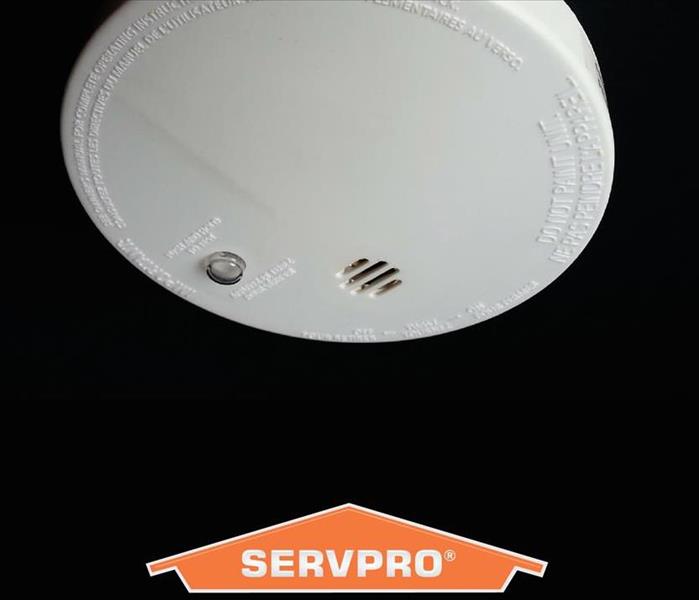 Fire Detectors Save Lives
Fire Detectors Save Lives
Every Second counts during a fire.
Fire experts agree; people have as little as two minutes to escape a burning home. That is why every second counts, it is critical to be prepared and have an escape plan in place. Once a plan is developed, it is important that everyone in the home understands the plan. The best way to do this is to practice the escape plan at least twice a year.
A survey by the American Red Cross shows only 26% of families have a fire escape plan in place.
Here are a few suggestions to help you develop an emergency escape plan.
- Consider escape ladders for sleeping areas on the second and third floors. Only purchase collapsible escape ladders evaluated by a recognized testing laboratory. (Store them by the window)
- Choose an outside meeting place a safe distance in front of your home where everyone can meet after they've escaped, emergency personnel will also be able to see you. Make sure to mark this on your plan.
- Teach children how to escape on their own in case you cannot help them.
- Practice your plan twice a year during the day and at night.
Increase your chance of surviving a fire by having working smoke/fire detectors in place, developing an escape plan, and then practicing the plan with the family.
At SERVPRO our priority is your safety. We are here to help you to prepare for possible disasters, and restore your home after a disaster strikes.
CELEBRATE SAFELY WITH A RECIPE FOR SAFETY
11/11/2016 (Permalink)
Each November, families gather to celebrate Thanksgiving by preparing a delicious feast, but if you don't practice safe cooking habits, your holiday could become hazardous very quickly. The leading cause of fires in the kitchen are unattended cooking. It's important to stay alert to prevent cooking fires.- Be On Alert! If you are sleepy or have consumed alcohol don't use the stove or stove top.
- Stay in the kitchen while you are frying, grilling, boiling or broiling food.
- If you are simmering, baking, or roasting food, check it regularly, remain in the kitchen while food is cooking, and use a timer to remind you that food is cooking.
- Keep anything that can catch on fire away from the stove top--that includes oven mitts, wooden utensils, food packaging, towels or curtains.
If you have a cooking fire, consider he following safety protocols to help keep you and your family safe. - Just get out! When you leave, close the door behind you to help contain the fire.
- Call 9-1-1 or the local emergency number after you leave.
- For an oven fire turn off the heat and keep the door closed.
- If you try to fight the fire, be sure others are getting out and you have a clear path out.
- Keep a lid nearby when you're cooking to smother small grease fires. Smother the fire by sliding the lid over the pan and turn off the stove. Leave the pan covered until it is completely cooled.
Have a safe Holiday Season!
Can You Do It In Under 2 Minutes?
10/20/2016 (Permalink)
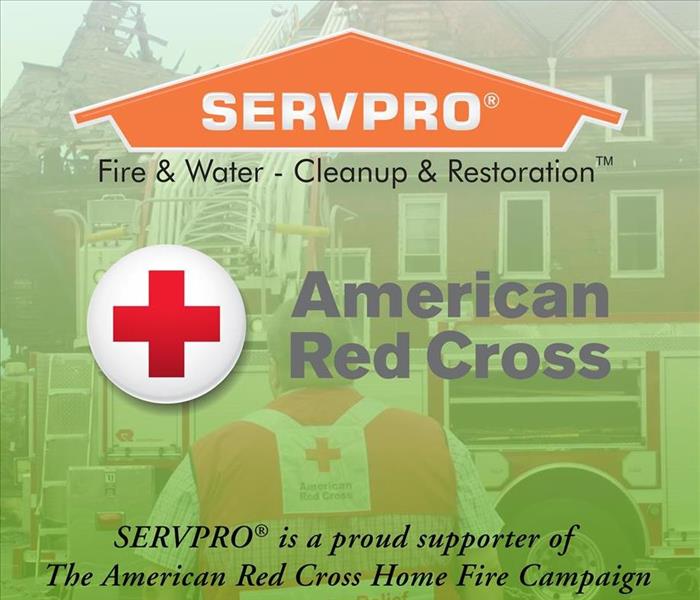 Fires Safety, Cleanup and Restoration.
Fires Safety, Cleanup and Restoration.
EXIT a Fire
Every Second Counts during a fire. Fire experts agree, people have as little as two minutes to escape a burning home before it's too late to get out.* In a matter of moments, a small flame can become a major fire, making it critical to be prepared and have an escape plan in place. Once a plan is developed, it is critical everyone in the home understands the plan; the best way to do this is by practicing the escape plan at least twice a year. Increase your chance of surviving a fire by ensuring you have working smoke detectors in place, building an escape plan, and then practicing the escape plan. The following are a few tips to help you develop a plan.
Draw a map of each level of your home and show all doors and windows. Find two ways to get out of each room. Make sure all doors and windows that lead outside open easily.
Consider escape ladders for sleeping areas on the second or third floors. Only purchase collapsible escape ladders evaluated by recognized testing laboratory.
Choose an outside meeting place a safe distance in front of your home where everyone can meet after they've escaped. Mark this place on your escape plan map.
Teach children how to escape on their own in case you can't help them. Plan for everyone in your home with special considerations for elderly or disabled individuals.
Practice your escape plan during the day and nighttime.
*Tips provided by the American Red Cross
Home Fires Occur More Often in the Winter Months
3/1/2016 (Permalink)
Did you know?
Home fires occur more often during the winter than in any other season.
A home or business fire can be a very stressful event. Damage to personal belongings and the contents of the building is just one concern. Timely mitigation is key to controlling damage, while reducing downtime and rocevery costs.
Be Prepared!
- Install Smoke Alarms- on every level of your home
- Test Smoke Alarms at least once a month
- Replace batteries at least once a year
- Replace all smoke alarms every 10 years
 Restoring fire and smoke damage is one of our specialties. Contact SERVPRO of Eastern Rockland County to learn more.
Restoring fire and smoke damage is one of our specialties. Contact SERVPRO of Eastern Rockland County to learn more.






 24/7 Emergency Service
24/7 Emergency Service









